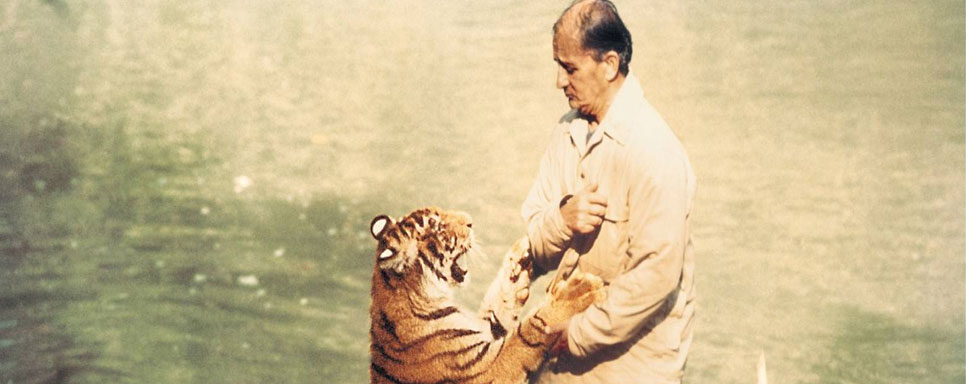Kunwar ‘Billy’ Arjan Singh

Dudhwa National Park, nestled in the Terai region of Uttar Pradesh, is a pristine sanctuary that attracts nature enthusiasts and wildlife lovers alike. Spanning over an area of approximately 680 sq km, this park is part of the larger Dudhwa Tiger Reserve. It is renowned for its rich biodiversity, featuring a tapestry of dense sal forests, lush grasslands, and intricate wetlands. Home to the majestic Bengal tiger and the elusive one-horned rhinoceros, Dudhwa is a haven for rare and endangered species. The park's tranquil ambiance, coupled with its remarkable flora and fauna, offers a serene escape into the heart of nature, where the symphony of bird calls and rustling leaves creates a harmonious backdrop for unforgettable wildlife experiences.
The history of Dudhwa National Park is rooted in its establishment as a wildlife sanctuary in 1958 to protect the swamp deer, locally known as barasingha. Recognizing its significant biodiversity and the need for greater conservation efforts, it was declared a national park in 1977. The park's conservation journey was further bolstered in 1988 when it became part of the Dudhwa Tiger Reserve under Project Tiger, highlighting its crucial role in tiger conservation. The legacy of conservationist Billy Arjan Singh, who championed the cause of wildlife protection in the region, is deeply intertwined with Dudhwa's history, marking it as a cornerstone of India's wildlife heritage. Let’s book Dudhwa safari tickets and learn about this silent hero, because of whom Dudhwa National Park, today, is on a platform of wildlife tourism.
Kunwar ‘Billy’ Arjan Singh
His personal life - Kunwar "Billy" Arjan Singh was an Indian conservationist and author who initially began his career as a hunter. Born in Gorakhpur on 15 August 1917, he was the second son of Kunwar Jasbir Singh, CIE (1887 - 1942), of the royal Ahluwalia dynasty of Kapurthala. His family included notable figures such as his grandfather, Raja Harnam Singh, his uncle, Raja Maharaj Singh, and his aunt, Rajkumari Amrit Kaur. Air Vice-Marshal Kunwar Jaswant Singh, PVSM, was his older brother. In 1940, Singh was commissioned as a Second Lieutenant in the British Indian Army and served in southern Iraq. After returning to India, he bought a farm in Lakhimpur Kheri and built a home named Jasbir Nagar in honor of his father. Settling into a life of farming and hunting, Singh later recounted his youthful passion for hunting.
His efforts for wildlife conservation - Although initially an avid hunter, Arjan Singh experienced a profound change of heart after killing a young leopard illuminated by his vehicle's headlights. Overcome with revulsion for what he had done, he vowed to dedicate himself to conservation. His first major conservation effort was focused on saving a herd of barasingha in the neighboring Sathiana range of the Dudhwa forest reserve. Singh's advocacy played a crucial role in persuading Prime Minister Indira Gandhi to designate Dudhwa as a 200-square-mile national park.
Singh is best known for his pioneering work in reintroducing leopards and tigers into the wild. He began by raising an orphaned male leopard cub named Prince and later two female leopards, Harriet and Juliette, allowing them all to roam freely. While Prince eventually returned to the wild, Juliette and her cubs perished due to flooding and poisoning, likely by local farmers, and Harriet also died from poisoning. With the assistance of Indira Gandhi, Singh transported a tigress cub named Tara from an English zoo and skillfully reintroduced her into the wild. This exceptional project was thoroughly chronicled in his books and in a film produced by Anglia Survival. Tara produced a litter of cubs, and despite some accusations of introducing Siberian tiger genes, Singh believed this genetic diversity would benefit the local tiger population.
His accomplishments - Arjan Singh was a pioneering conservationist, renowned for his groundbreaking efforts to reintroduce tigers and leopards from captivity back into the wild. His significant contributions to wildlife conservation earned him widespread recognition. He was honored with the Padma Shri, one of India's highest civilian awards in 1995. The following year, he received the World Wildlife Gold Medal and, in 1997, the Order of the Golden Ark. In 2004, the World Wildlife Fund gave him the Getty Award for his innovative conservation work and efforts in raising public awareness. In 2006, he received two additional accolades and was ultimately honored with the Lifetime Award for Tiger Conservation.